Major Grant's Diary
9th - 12th June 1940
Major James Murray Grant was with 2nd Seaforths in the closing stages of the withdrawal to St. Valéry. The Highlanders Museum and Queen's Own Highlanders Collection have very generously provided a scan of the diary compiled by Major Grant while a prisoner of war. Scans of the pages of this diary covering the period 9 to 12 June can be seen in full here. Several of his excellent maps have also been reproduced below to support the transcript. The writing has been difficult to read in parts and apologies are made for any mistakes. Some abbreviations and notes have been inserted using [square brackets] to distinguish these additions from Grant’s own bracketed comments within the original text.
A Transcript from Major Grant's Diary
2nd Seaforth Highlanders
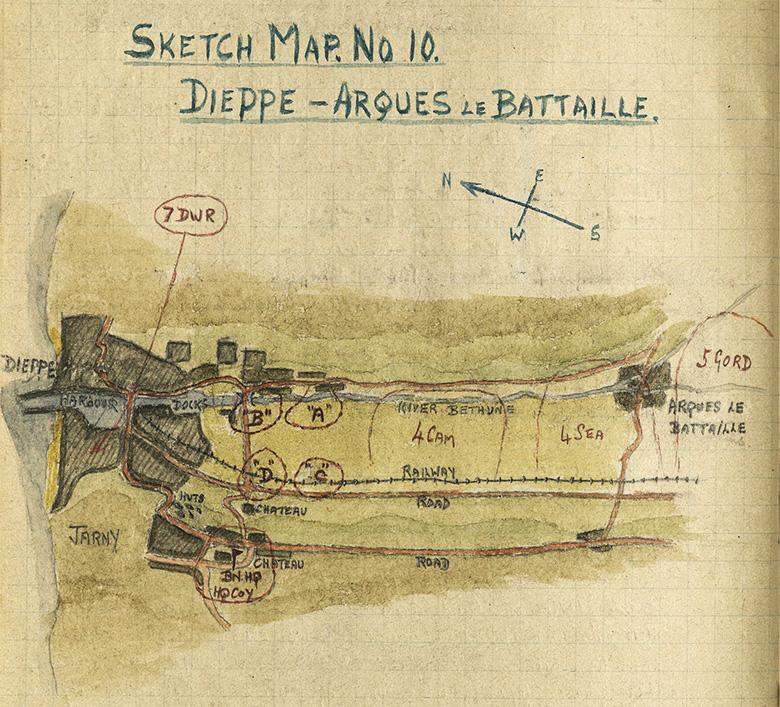
Major Grant Map (No.10), Dieppe
show infoDescription:
Sketch map from Major Grant's diary relating to positions around Dieppe on 9th June 1940
High Resolution Image:
Tags:
9th June
0100hrs Adjt & 1D/R [Adjutant & dispatch rider] went to Bde [Brigade] to report our arrival & position. 0200 hrs L.O. [Liaison Officer] arrived with orders that we were to man defensive position at once. The men were roused once more while C.O. [Commanding Officer] gave out orders and we moved off to position at about 0220. Bn. H.Q. & H.Q. Coy [Battalion Headquarters & Headquarter Company] established in Chateau. Coys disposed as under. A right behind river B left responsible for bridge. D & C in support on lie of railway & road. 7 DWR [Duke of Wellington's Regiment] positions were taken over & 7 DWR closed on the left in Dieppe. 4 Camerons on our right followed by 4 Seaforth to ARQUES & then 5 Gordons beyond. It was an extremely dark night and companies had great difficulty in finding their way to positions. It was intended to establish Bn. H.Q. in the lower chateau but it was found to be occupied by ? troops & also the top chateau was easily soon found.
By 0730 all Coys were in position. 1100, the two officers & 30 OR's [Other ranks] we should have picked up in FORET D'ARQUES arrived via 4 Seaforths. (We had sent out twice at 0600 & 1100 hours to find them.) The officers Capt. Hildreth & 2/Lt Hannay posted to D & A Coys respectively. The Q.M. [Quartermaster] was still missing but was found during the day with 4 Seaforths. At 1430 Bde. Cmdr. Col. Barclay visited Bn. to clarify orders re blowing of bridge in B Coy front. He also ordered Maj. Walford & 2/Lt C. Mackenzie to go to the A.D.S. [Advanced Dressing Station] Maj Walford was evacuated home with concussion. 2/Lt C. MacKenzie refused to evacuated and returned to duty. Although incapable of strenuous duty he carried on & did very useful work as I.O. [Intelligence Office]. A list of 60 promotions made necessary by casualties was complied. (Actually it was never published.) 2000 C.O. went to conference at Bde. 2100 hrs we heard BBC for the last time, & in the news we heard that we "the 51 Div. is still fighting alongside their gallant allies on the Somme"!! At 2230 C.O returned to Bn. H.Q. Coy. Commanders had already been called in, & C.O. gave orders for further withdrawal. It was at this conference that officers present kept falling asleep through sheer exhaustion, with the result that it took over an hour to get the orders out.
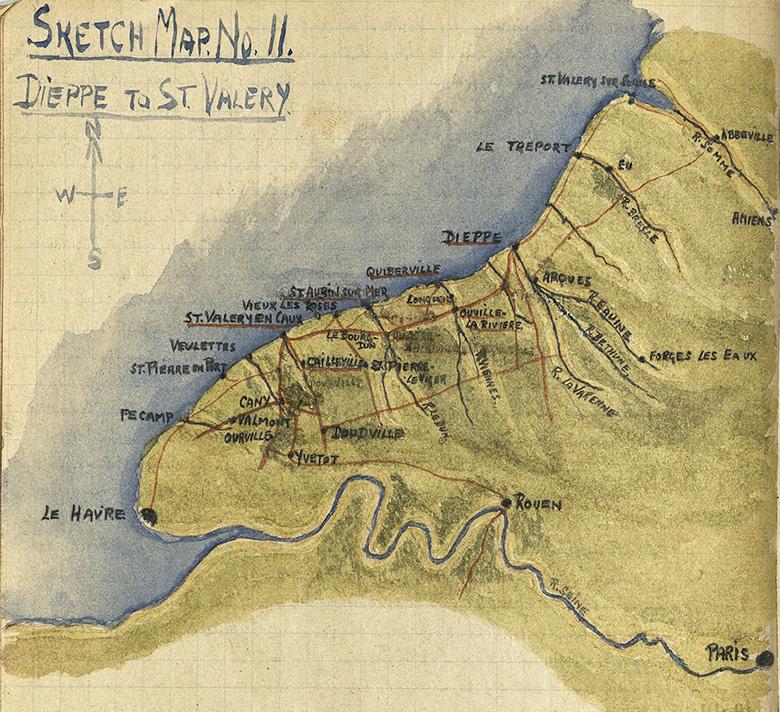
Major Grant Map (No11), Dieppe to St Valery
show infoDescription:
Sketch map from Major Grant's diary showing the route from Dieppe to St. Valery.
High Resolution Image:
Tags:
The general plan was that 51 Div. would withdraw to LE HAVRE in a series of brigade blocks. 154 were to go straight through the line FECAMP-BULBEC, 2 Bns. 152 Bde. (2 Seaforth & 4 Camerons) & 1 Bn. 153 Bde. (1 Black Watch) to line QUIBERVILLE - LONGEVIL - OUVILLE LA RIVIERE, on the River VIENNE while 1 Bn. 152 Bde. (4 Seaforths) & 2 Bns. 153 Bde. (1 Gordons & 5 Gordons) (7 DWR) held the line DIEPPE - ARQUES LE BATAILLE on the river BETHUNE. These line would then withdraw through each other onto the LE HAVRE where we were to embark. The Bn. Plan was Coys to hand over back to 7DWR 0245, RV at Bn H.Q. and proceed by march rate to LONGVILLE. A & B Ech. tpt & 4 Pl. to move off at 0130 hrs. Major Grant to go off immediately to reconnoitre the position & be ready to meet Bn. on arrival. B Coy. Bridge was to be blown on written orders from Bde, for which purpose a D/R was kept standing by at Bde. H.Q. this bridge was blown at 2400 hrs by Capt. Hobkirk, last troops across being checked by Maj. NASON. There was little or no enemy activity on our front during the day & night.
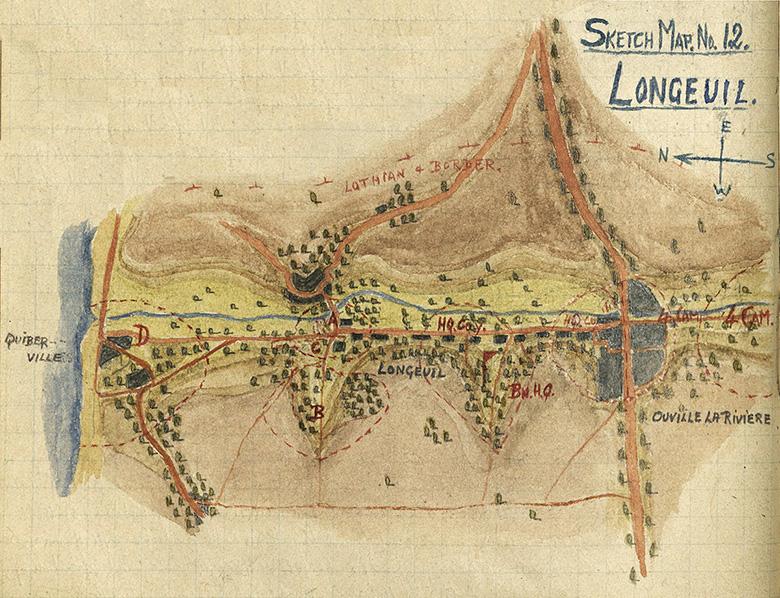
Major Grant Map (No.12), Longeuil
show infoDescription:
Sketch map from Major Grant's diary relating to positions around Longeuil on 10th June 1940
High Resolution Image:
Tags:
10 June
The Bn. marched off at ... hours, arriving at LONGVILE at ... Maj. Grant met the Bn. 3 miles out of LONGVILE & took C.O. round position. Coys on arrival were led out to their respective areas, positions as shown in sketch map no. 12. (These were the final positions.) Bn. H.Q. first in one the houses in LONGVILE but later up a re-entrant & a wood there. 4 Camerons were on our right. Their Adjt. (Capt. Derek Lang) come over at about 11 to arrange battle H.Q. which would be convenient to both. Div. H.Q. arrived into the chateau at OUVILLE-LA-RIVIERE at ... The house where Bn H.Q. was first was a lovely one, well furnished & complete in every respect even to toilet paper in the WC. We had a grand breakfast/lunch here & this was our last decent meal. All during the day squadron after squadron of German planes passed overhead. We were not bombed ourselves, but a great a pall of black smoke could be seen down the coast, drifting up the Channel. We presumed that this was St. VALERY & LE HAVRE receiving attention.
Coys. were in position with trenches dug at 1200 hours. At 1500 a message was received ordering the general "Stand to", and to be prepared to meet attack from front OR REAR. B Coy. was hastily turned about, & positions for the other Coys reconnoitred. Orders were received from Col. Barclay that Major Grant was to take over the second in command, Major Nason to take over H.Q. Coy, Capt. Hobkirk to take over B Coy. This was done. 1600 C.O & Adjt visited H.Q. 4 Camerons, & while there received orders from Division to the effect that (a) the Bn. would probably be required to move by M.T. (motor transport) at very short notice & (b) that all equipment & baggage not absolutely essential for fighting was to be jettisoned immediately. (c) nothing was to be burnt in case smoke gave away positions & (?) intention. The Adjt. returned immediately and sent for Coy Comdrs. 1645 CO. having visited Div. returned & gave orders to scrap everything except (a) all weapons/ammunition. (b) all vehicles. (c) 1 haversack ration per man (d) all food. Most of Bn. documents were buried, the essential few & some 20,000 francs were taken on. All person kit except what we stood up in had to go.
At 1800 hrs Division called for return of personnel still to be carried by M.T. after filling unit tpt to maximum capacity. 385 could be carried by unit M.T. C.O. went to Division with reply, & returned 1840 with orders for withdrawal. The situation was the enemy were known to be in CANY with forward elements in the area of St.VALERY, which elements had been encountered by the Lothian & Border Horse. The Division, less 154 Bde. on the FECAMP – BULBEC line, were therefore cut off from LE HALVE, where it had been intended to embark. 2 Seaforth were to proceed with all possible haste to St VALERY as soon as the M.T. arrived, acting as advanced guard, & to take up a position securing the bridgeheads at River DURENT, about 3 miles west on the town. 1 Gordons to follow & come in our left & a French Regt on our right up the sea coast. (This French unit never arrived at all).
2030 the Bn was embussed, & moved off. The vehicles, French, had been found about an hour earlier but the drivers had vanished. We had another nightmare drive to St VALERY. We drove full out. It was still broad daylight & we expected to be bombed out of existence at any moment. By pure luck we got through just before the roads got completely jammed with French military and civilian vehicles flying to St VALERY.
At 2215, the Bn. column led by 4 Pl arrived in the square at St VALERY, which luckily was fairly clear of troops & vehicles. (An hour or so later it was a seething mass.) We found on questioning some officers & men there that there was considerable confusion and alarm. Some units proceeding towards FECAMP had run into enemy AFVs [Armoured Fighting Vehicles] & had been driven back. Others coming from the direction of CAMY reported the same situation. The town is in a deep hollow, the cliffs rising steeply on East and West and way out difficult to find. It was decided that Major Grant should go back as fast as possible to H.Q Division & report the situation personally, suggesting that instead of trying to secure the line of the River DURENT, we should hold the short line on the heights above & West of St VALERY itself. From the map & reports this appeared to offer more natural obstacles from attack by AFV’s.
Major Grant went off at 2230, but owing the extraordinary congestion on the road, it was passed midnight before he reached OUVILLE - LE - RIVIERE. On arrival there, he found the GOC & G1 alone, the rest of Div. H.Q. having moved. (There were 8 French generals there also but they were doing nothing - just sitting like 3 dummies on a sofa!) Having heard the report the GOC ordered that the Bn. should take up an intermediated line instead i.e. to hold LE TOT & ST. SYLVA themselves.
Major Gant returned to St VALERY. The congestion & confusion was indescribable & it was not until 0430 or 0500 that he eventually got back to Bn. H.Q. French columns of M.T. had cut in on the main road, allotted to 51Div. & in trying pass our columns had created solid blocks of vehicles 3 abreast for stretches of up to a mile long on the road. The Bn. meanwhile took up positions on heights of St V. (NOTE: by now the enemy were between 154 Bde. and the remainder of the Division. The Comdr. (Brig Clarke) had had ordered that if this situation occurred, he was to act on his own initiative. The foresight of this order was proved & this Bde. succeeded in reaching LE HAVRE & got away.)
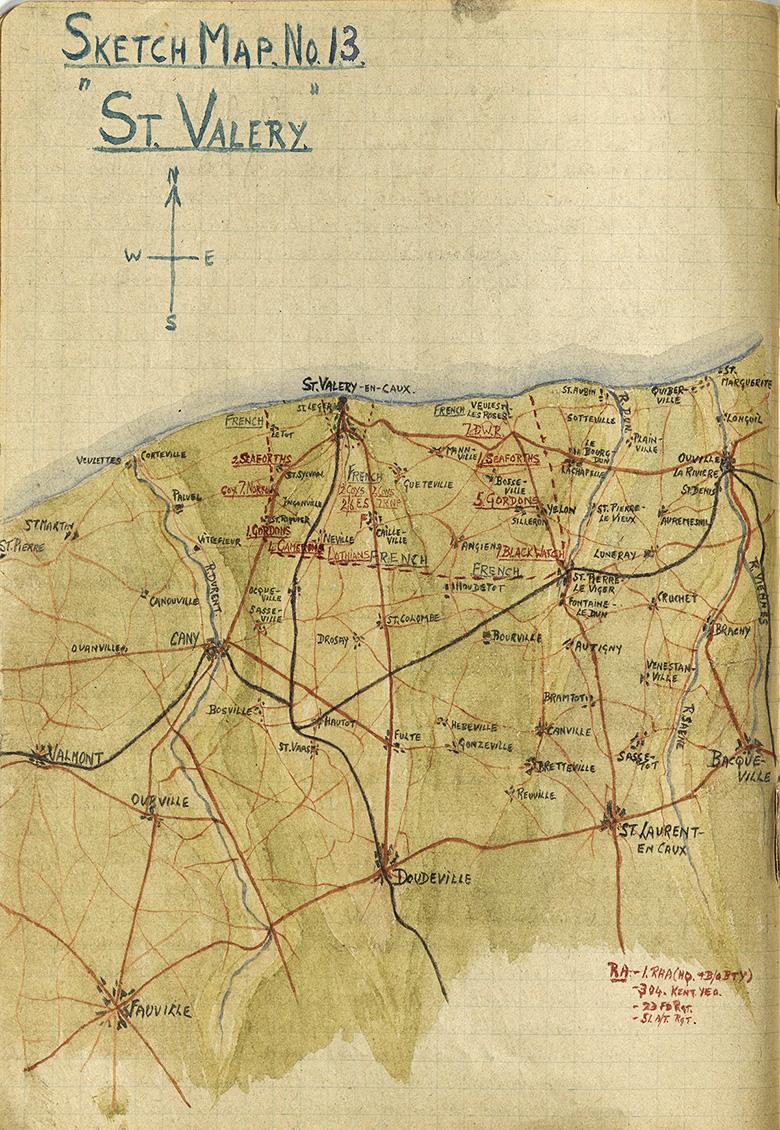
Major Grant Map (No.13), St Valery
show infoDescription:
Sketch map from Major Grant's diary relating to positions around St. Valery on 11th June 1940
High Resolution Image:
Tags:
11 June
Dawn found the Bn. holding an unprepared position on the heights outside the West of the town. Major Grant returned with the new orders at about 0430 or 0500. CO gave out orders for advance as follows. 0500 4 Pl followed by A to recce wood "P" on sketch. A start line to be formed on track SW of this wood. 4 Pl to recce St. SYLVAN & LE TOT. Bn. to advance on St SYLVAN. This was carried out without opposition, 4 Pl meeting elements of Lothians near St S. A Coy was sent out to occupy LE TOT immediately on arrival at St SYLVAN. After arrival at St SYLVAN CO went round the position. The French Regt, which should have held LE TOT to the sea had not (& never did) arrive. The front, Sea - St SYLVAN was some 2,500 X with gaps (a) Sea to LA TOT. (b) LA TOT - St SYLVAN. (c) St SYLVAN - INGONVILLE, where 1 Coy, 7 Norfolks, came into position. These gaps were held as well as possible by small arms fire, but we had no Artillery or Anti-Tank guns. CO decided to strengthen LE TOT & sent D Coy across at about 1100 hours. 1 sec MG (RNF) (Royal Northumberland Fusiliers) was found wandering about & sent also to LE TOT.
The position was obviously untenable against AFV attack without Artillery & A-Tk support, & Major Grant was sent again to HQ Div. now at CAILLEVILLE, to report and ask for this support as a matter of urgency. He left at 1100 hrs found St VALERY & Eastern outskirts full of French troops and vehicles. Found HQ Div. & saw GOC personally. GOC said he was anxious about our position, that the Artillery support would be given as soon as possible also more MG's would be sent up. 1230 Arty Liaison office (Capt. Nicholson B/O Bty. RHA) (1st Regiment Royal Horse Artillery were attached troops). arrived with W/T, & was sent to A Coy at LE TOT. 1300 2/Lt Burnett 51 ATK. Rgt. arrived to recce for his gun positions. He returned to bring up his guns but met the German attack as he was on his way out with them. He himself was badly wounded & we never saw the guns. It should be note also that although arty Liaison office had come up, the German attack came up so quickly that were unable to get much affective fire to take them on, largely owing to them not being allowed to register at all, owing to the uncertainty of whether the French troops were still out there.
About 1400, a squadron of French cavalry rode into the St SYLVAN position & said they were going to stay there! They could give no information as to the enemy & very little account of their own role.
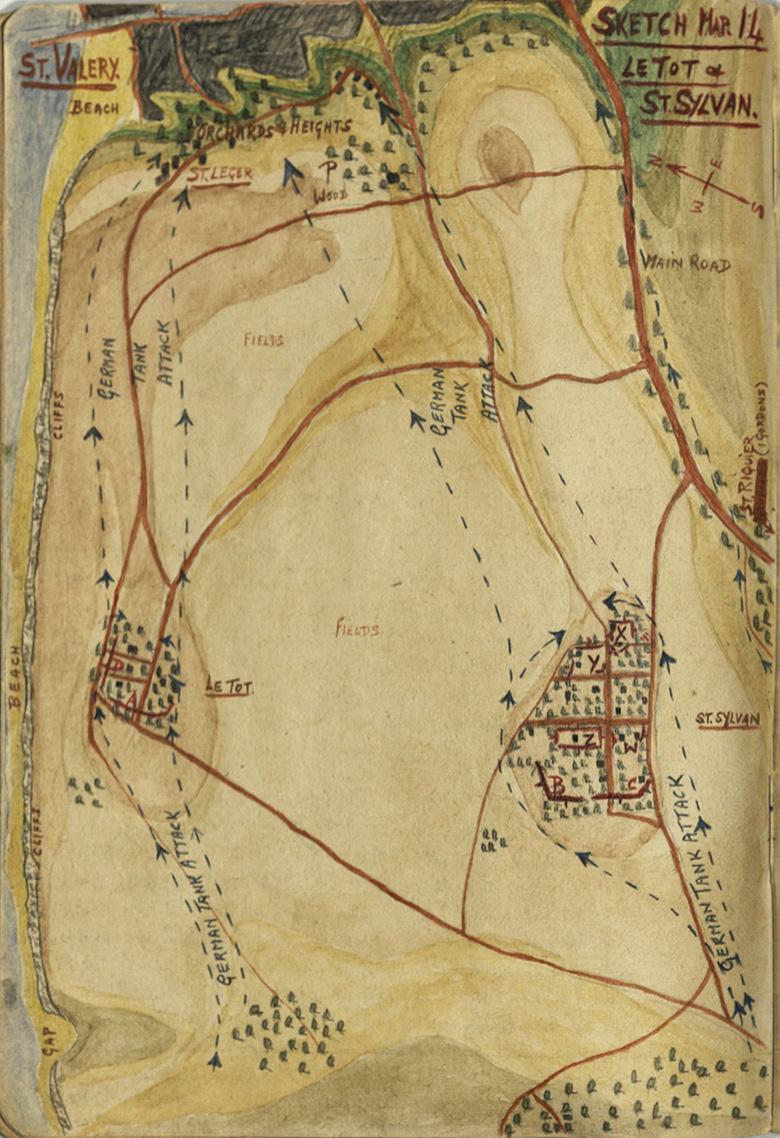
Major Grant Map (No.14), Le Tot
show infoDescription:
Sketch map from Major Grant's diary relating to positions around Le Tot & St. Sylvan and German Tank movements. 11th and 12th June 1940.
High Resolution Image:
Tags:
At approx. 1430, an exhausted runner from A Coy arrived at Bn. H.Q. to say that 40 or 50 German tanks were advancing on LE TOT. Simultaneously a message came from the left of the St SYLVAN position saying that 50 German tanks were advancing thorough that gap. The mortar Pl. was rushed out, with whatever ammunition they had left, to the left of the Bn, HQ position & opened fire, but within a few minutes the tanks had arrived all round the Bn. HQ & were firing into us from 3 sides whilst mortar, & MG. fire came from the 4th side.
Bn. HQ position (X marked on sketch) consisted on earth bank on 3 sides with a cottage & thick hedges on the village side. With the limited tools available we had been able to scratch only narrow shallow cover in the earth banks. We had no A/Tk weapons except A/Tk rifles. The fire was intense & we suffered between 30 & 40 killed & wounded in the position within a few minutes. Three enemy tanks were knocked out by anti tank rifle fire. The furthest out about 200 x & the nearest at 50 x. It is thought that perhaps the knocking out of these tanks saved us from being completely overrun, because after a few minutes, which seemed like hours, the main part of the attack swept on to St VALERY.
It is not known how long this place lasted, the cottage, the RAP in a barn and several of our vehicles were on fire. We were still under pretty heavy fire, & the position was clearly untenable. A hurried move was made therefore to a second position marked Y on the sketch map. The Bn. vehicles had to left in the position X. The barn in which the R.A.P. [Regimental Aid Post] had been established was blazing by this time and a volunteer party was called for to evacuate the wounded. It was found that our doctor Lt. McKillop RMC. [Royal Army Medical Corps] & practically the whole of his staff had been either killed or wounded. McKillop himself was hit in the groin, & his left leg broken in three places besides other wounds. In spite of this he tried to direct operations himself, and refused to be moved until the last live man had been got out. It was a ghastly task as we had no stretchers & only a few gates & doors on which to move the worst cases. The others had to be pulled out anyhow if we were to save them from being burnt to death. All living were got out but 8 dead had to be left, as owing to the flames & the enemy fire which was causing more casualties, it was impossible to get them out without further loss of life. (Before deciding on this course Major Grant assured himself by person investigation that those left were in fact dead beyond all possible doubt.) McKillop, when his turn came to be moved, asked to be left behind. He realised that his wounds were mortal & did not want to endanger anyone else any further. He was of course moved, but died that night, a most gallant officer.
The actions of the French squadron during this time deserves comment. On the first round being fired they cut loose their horses, & instead of assisting us in defending the position the majority rushed about trying to find cover. Eventually, their commander was found, & told that he & his men would either fight under our orders or be cleared out of the position. He chose the former, but as the fire slackened about half his men crept away into the village & we never saw them again. The other half took over a sector of our Y position & fought well, particularly after their comdr. was killed & his Second in Command took over.
After getting the wounded back to position Y Lt. Colin MacKenzie realising that the remainder of our ammunition was still in position X, alone & on his own initiative ran over & drove out a truck containing ammunition, as small quantity of water and a case of biscuits. The truck was burning at the time. Some of the ammunition was exploding in the truck. Whilst doing this he was hit in the head by a shell splinter. His action enabled the Bn. to fight on longer, & procured water which was badly needed for the wounded.
During this time A & D Coys. at LE TOT suffered very badly, were more or less overrun, and after the main tank attack had gone on the St VALERY they decided to try to get back to X ... X. Major Fraser, Capt. Hildrith, 2/Lt Blair, 2 Pls. of D Coy and some oddments were completely cut off & surrounded by tanks & were forced to surrender at about ... hours. Major Ritchie comd D Coy was killed. The remainder appeared to have got out of the village & wood, but were either killed or captured before reaching the town. It is known that a number lost their lived trying to get down the cliffs. B & C Coys. in front of St SYLVAN had up to this time been left more or less unmolested. Only one tank cruising round their position. On our left we could see the 7 Norfolk position being shelled, & tanks cruising up the road between us, but could not see whether A & D or 7 Norfolk were still in their position nor could we get any communication with them.
1600 hrs cipher destroyed by burning. The battle died down considerably towards the evening, but any movement on the edge of the village which was still picketed by enemy tanks drew fire. As ammunition, particularly A/TK, was running short & as it was obvious that we were cut off & could not hold position Y against further attack, a third position Z was reconnoitred & Bn. HQ & HQ Coy moved into it. 1 Eight Cwt [one eight hundred weight] truck & 1 fifteen Cwt were salvaged and brought into the position. All the remainder had been destroyed. As we had no more mortar ammo. The mortars were destroyed. The roads round this position were blocked, & with farm implements shallow cover was dug in the banks.
Patrols were sent out at frequent intervals through the gardens & all reported tanks still in the vicinity. About ... hrs Capt. Tailyour volunteered to attempt a dash out of the village & into St VALERY to report our situation and to ask for help. Cpl. EVERDEN, volunteered to go with Tailyour. The road blocks were cleared and they drove off in the 8 Cwt truck. We heard firing a minute or so later, and as they did not return a patrol went out to seen what had happened. The reported no sign of Tailyour but a damaged German car was seen on the road. Tailyour, was severely wounded in the arm in making this attempt, but succeed in getting through to St VALERY. A very good show. We of course did not know whether he had got through or not.
Towards dark B & C Coys Comdrs were called in for a conference as to what action we should take. The factors were: (a) We were cut off. & assistance from St VALERY problematical. (b) Ammunition was nearly finished. (c) Food completely finished. (d) Men & officers exhausted. (e) We could no longer fulfil our role of defending this approach to St VALERY. (f) We had 45 wounded, some very badly, no doctor or medical aid, & some of the wounded had already died from lack of attention. (g) A French civilian had been found in the village who had volunteered to guide us to a way down the cliffs below which there was a path into St VALERY. It was decided to a make an attempt to reach St VALERY by way of the cliff path. A message to this effect was sent with 4 volunteers, each being giving the message verbally, to A & D Coys at LE TOT. (A & D had of course gone by this time but we did not know this.) As soon as it was properly dark the wounded were placed on gates, barn doors, & anything available as we did not have a single stretcher.
Bn. HQ, C Coy, HQ Coy, & wounded, B Coy. The column reached the edge of the wood but progress had been so slow that it was realised that it would be impossible to reach the cliffs before daylight. It should be realised also that our effective fighting strength was reduced by some 180 men (allowing only 4 to each wounded & in many cases 6 were required to carry the gate or door & hold the wounded man on it) & our rate of march could only be a very slow crawl. It was decided therefore to return to position Z again, drawing B and C Coys. into a smaller perimeter & to make the attempt again the following night leaving the wounded with a small party to surrender as soon as the remainder had got away. The remnants of the French sqn. were given a post (W on Sketch) across the road from our perimeter, but they all cleared off during the night. It was a miserable night altogether & to add our discomfort it rained for the first time weeks.
12 June
During the morning & early afternoon there was intermittent snipping, chiefly by Tommy guns. Cottages round our position were fired by the enemy apparently to indicate our position. Patrols were sent out at intervals as on the previous days but never bumped the enemy patrols. A flight of British Hurricanes flew over us amid cheers from our men. These were the only British planes we had seen for days. We tried to signal them, tearing up sheets etc. from the cottages & laying our Div sign on the ground but they gave no sign of recognition. (One of the pilots F/O DERYK UPTON a Canadian was subsequently shot down and joined us in the prison camp.) [the deletion is in the author's note book]
During the early afternoon the first signs that all was NOT well in St VALERY became apparent. Through field glasses we could see what appeared to be prisoners being lined up on the edge of the cliff near the orchards & being take back towards LE TOT. We had however no idea that the Division had surrendered. During the day four German vehicles, came round a corner in the village, taking us by surprise & got away. Later a tank came down the road from Y to Z. We opened fire at very close range & set it on fire, the crew tumbling out & escaping round position W.
At about 1430, CQMS. Fields who had been captured was brought near to our position on a taken & sent in to us. He had been interviewed by the German commander & send in with a message that "unless we surrendered we would be blown to bits". Fields could not tell us exactly what had happened in St VALERY to the Division, but said that German Infantry, MGs, & tanks were on the outskirts between us and the town itself. The CO. called officers to a conference where Major Grant on behalf of the CO explained the situation. The alternatives were (a) to fight it out in our present position. (b) to attempt a mass breakout by day light. (c) to try to hang on to night fall & attempt to get away in small parties leaving the wounded. (d) to surrender. Opinions were given and on a vote being taken it was decided to carry on the fight. When the officers left the conference it was seen that through some mistaken order a party of our men were carrying our wounded towards the German lines. How this mistake occurred has never been ascertained owing to the speed of events thereafter.
When stand to was ordered it was apparent that the fight could not be carried in that position and that all the men were so utterly exhausted after 12 days or continuous marching and digging without proper food or rest & with heavily fighting on 8 of those days, that the majority were almost were incapable of carrying on even if they had sufficient ammunition & arms. The only course left was to call for volunteers to attempt breaking out in small parties. Every office formed a party & prepared to escape, Capt. Hobkirk showing particular drive & energy in doing this. The number of volunteers had never been properly ascertained. These parties crept into various areas & places in & near the village & escaped from them under cover of darkness. The rest remained with the wounded. All were rounded up & captured between the 13th and 18th except 2/Lt RICHARD BROAD .who with 4 men reached home some 14 months later [an account of Broad's escape can be read here].
This diary, which from 23 May is the Bn. war diary complied from diaries & notes of officers take prisoner, have been read & approved by Col. Barclay, Majors Boner, Grant, Nason, Fraser & Murray.
Was made left with the Adjt. Lt. P Mitford at ...
[Part of the end of the document is illegible and torn]
The remarkable story of 2nd Lieutenant Richard Broad's escape from St. Valery. Reproduced, with kind permission, from Saul David's book, Churchill's Sacrifice.
Division History References :
General Fortune considered all the options, a counter attack, further resistance, retaking the town but against this there was no possibility of evacuation or support, the men were exhausted and virtually out of ammunition, with no artillery ammunition at all. Shortly before 1000hrs on the 12th June General fortune took the most difficult of decisions - to surrender...
